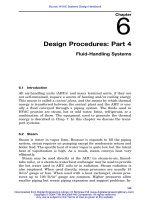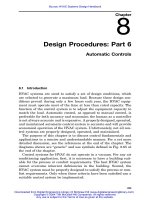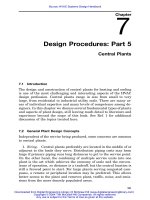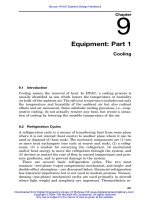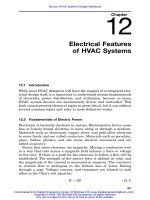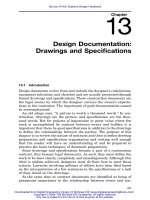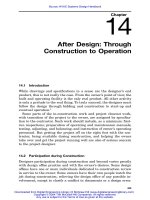Tài liệu HVAC Systems Design Handbook part 1 pdf
Bạn đang xem bản rút gọn của tài liệu. Xem và tải ngay bản đầy đủ của tài liệu tại đây (90.18 KB, 14 trang )
1
Chapter
1
HVAC Engineering Fundamentals:
Part 1
1.1 Introduction
This chapter is devoted to ‘‘fundamental’’ fundamentals—certain prin-
ciples which lay the foundation for what is to come. Starting with the
original author’s suggested thought process for analyzing typical prob-
lems, the reader is then exposed to a buzzword of our time: value
engineering. Next follows a discussion of codes and regulations, polit-
ical criteria which constrain potential design solutions to the bounds
of public health and welfare, and sometimes to special interest group
sponsored legislation. The final sections of the chapter offer a brief
review of the basic physics of heating, ventilating, and air conditioning
(HVAC) design in discussions of fluid mechanics, thermodynamics,
heat transfer, and psychrometrics. Numerous classroom and design
office experiences remind us of the value of continuous awareness of
the physics of HVAC processes in the conduct of design work.
1.2 Problem Solving
Every HVAC design involves, as a first step, a problem-solving pro-
cess, usually with the objective of determining the most appropriate
type of HVAC system for a specific application. It is helpful to think
of the problem-solving process as a series of logical steps, each of
which must be performed in order to obtain the best results. Although
there are various ways of defining the process, the following sequence
has been found useful:
1. Define the objective. What is the end result desired? For HVAC
the objective usually is to provide an HVAC system which will control
Source: HVAC Systems Design Handbook
Downloaded from Digital Engineering Library @ McGraw-Hill (www.digitalengineeringlibrary.com)
Copyright © 2004 The McGraw-Hill Companies. All rights reserved.
Any use is subject to the Terms of Use as given at the website.
2 Chapter One
the environment within required parameters, at a life-cycle cost com-
patible with the need. Keep in mind that the cost will relate to the
needs of the process. More precise control of the environment almost
always means greater cost.
2. Define the problem. The problem, in this illustration, is to select
the proper HVAC systems and equipment to meet the objectives. The
problem must be clearly and completely defined so that the proposed
solutions can be shown to solve the problem.
3. Define alternative solutions. Brainstorming is useful here.
There are always several different ways to solve any problem. If re-
modeling or renovation is involved, one alternative is to do nothing.
4. Evaluate the alternatives. Each alternative must be evaluated
for effectiveness and cost. Note that ‘‘doing nothing’’ always has a cost
equal to the opportunity, or energy, or efficiency ‘‘lost’’ by not doing
something else.
5. Select an alternative. Many factors enter into the selection
process—effectiveness, cost, availability, practicality, and others.
There are intangible factors, too, such as an owner’s desire for a par-
ticular type of equipment.
6. Check. Does the selected alternative really solve the problem?
7. Implement the selected alternative. Design, construct, and op-
erate the system.
8. Evaluate. Have the problems been solved? The objectives met?
What improvements might be made in the next design?
Many undertakings fail, or are weak in the end result, due to failing
to satisfy one or more of these problem-solving increments. There is
an art in being able to identify the key issue, or the critical success
factors, or the truly beneficial alternative. Sometimes the evaluation
will be clouded by constraint of time, budget, or prejudice. Occasion-
ally there is an error in assumption or calculation that goes un-
checked. The best defense against disappointment is the presence of
good training and good experience in the responsible group.
1.3 Value Engineering
Value analysis or value engineering (VE) describes a now highly so-
phisticated analytical process which had its origins in the materiel
shortages of World War II. In an effort to maintain and increase pro-
duction of war-related products, engineers at General Electric devel-
oped an organized method of identifying the principal function or ser-
vice to be rendered by a device or system. Then they looked at the
current solution to see whether it truly met the objective in the sim-
plest and most cost-effective way, or whether there might be an alter-
native approach that could do the job in a simpler, less costly, or more
HVAC Engineering Fundamentals: Part 1
Downloaded from Digital Engineering Library @ McGraw-Hill (www.digitalengineeringlibrary.com)
Copyright © 2004 The McGraw-Hill Companies. All rights reserved.
Any use is subject to the Terms of Use as given at the website.
HVAC Engineering Fundamentals: Part 1 3
durable way. The results of the value engineering process now per-
meate our lives, and the techniques are pervasive in business. Con-
sider our improved automobile construction methods, home appli-
ances, and the like as examples. Even newer technologies such as
those pertaining to television and computers have been improved by
quantum leaps by individuals and organizations challenging the
status quo as being inadequate or too costly.
Alphonso Dell’Isolo is generally credited as being the man who
brought value engineering to the construction industry, which indus-
try by definition includes HVAC systems. Dell’Isolo both ‘‘wrote the
book’’
1
and led the seminars which established the credibility of the
practice of value engineering in architectural and engineering firms
and client offices across the land.
There is a national professional society called SAVE (Society of
American Value Engineers), headquartered in Smyrna, Georgia. The
society certifies and supports those who have an interest in and com-
mitment to the principles and practices of the VE process.
Value engineering in construction presumes an issue at hand. It can
be a broad concern such as a system, or it can be a narrow concern
such as a device or component. The VE process attacks the status quo
in four phases.
1. Gather information. Clearly and succinctly identify the pur-
pose(s) of the item of concern. Then gather information related to per-
formance, composition, life expectancy, use of resources, cost to con-
struct, the factors which comprise its duty, etc. Make graphs, charts,
and tables to present the information. Identify areas of high cost in
fabrication and in operation. Understand the item in general and in
detail.
2. Develop alternatives. First ask the question, Do we even need
this thing, this service at all? Or are we into it by habit or tradition?
If the function is needed, then ask, How else could we accomplish the
same objective? Could we reasonably reduce our expectation or ac-
ceptably reduce the magnitude of our effort? Could we eliminate ex-
cess material (make it lighter or smaller)? Could we substitute a less
expensive assembly? Could we eliminate an element of assembly la-
bor? Could we standardize a line of multisize units into just a few
components?
In this phase, we learn not to criticize, not to evaluate, for the ‘‘cra-
zies’’ spawn the ‘‘winners.’’ ‘‘Don’t be down on what you are not up on.’’
Be creative and open-minded. Keep a written record of the ideas.
3. Evaluate the alternatives. Having developed ideas for different
ways of doing the same thing, now evaluate the objective and subjec-
tive strengths and weaknesses of each alternative. Study performance
HVAC Engineering Fundamentals: Part 1
Downloaded from Digital Engineering Library @ McGraw-Hill (www.digitalengineeringlibrary.com)
Copyright © 2004 The McGraw-Hill Companies. All rights reserved.
Any use is subject to the Terms of Use as given at the website.
4 Chapter One
versus cost—cost both to construct and to operate. Look for the alter-
native which will work as well or better for the least overall cost. This
will often be a different solution from the original.
Note that an analysis effort solely for the purpose of cutting cost is
not really value engineering; for the objective of minimized life cycle
cost is often compromised. There are enough buildings in this country
with fancy finishes and uncomfortable occupants to attest to this as-
sertion. As John Ruskin said many years ago:
It is unwise to pay too much but it is worse to pay too little. When you
pay too much you lose a little money. When you pay too little you some-
times lose everything, because the thing you bought was incapable of
doing the thing it was bought to do. The common law of business balance
prohibits paying a little and getting a lot—it can’t be done. If you deal
with the lowest bidder it is well to add something for the risk you run.
And if you do that you will have enough to pay for something better.
4. Sell the best solution. This ties back into a weakness of many
engineers and designers: They have great ideas, but they have a hard
time getting these ideas implemented. By first understanding the pur-
pose of a device or system, then producing good data to understand
current performance, and finally developing an alternative with doc-
umented feasibility, the sales effort is greatly supported.
Gas forced-air furnaces are an example of an HVAC unit which has
been improved over time by value engineering. The purpose of the
furnace now, as before, is to use the chemical energy of a fuel to warm
the environment, i.e., to heat the house. But there is a world of dif-
ference between the furnace of the 1930s, with its cast-iron or heavy-
metal refractory-lined firebox and 4-ft-diameter bonnet, and the high-
technology furnaces of today. Size is down, capacity is up, weight is
down, relative cost is down, fuel combustion efficiency is up, and re-
liability is debatably up.
Variable-speed drives for pumps and fans are devices which have
been improved to the point of common application. The operating-cost
advantages of reduced speed to ‘‘match the load’’ have been known
and used in industry for a long time, but technology has taken its time
to develop reliable, low-cost, variable-speed controllers for commercial
motors, such as variable-frequency drives now used in HVAC appli-
cations.
If value engineering seems to share some common analytical tech-
nique with Sec. 1.2 on problem solving, the dual presentation is in-
tentional. Both discussions are approaches to solving problems, to im-
proving service. The first is an interpretation of a mentor’s example,
HVAC Engineering Fundamentals: Part 1
Downloaded from Digital Engineering Library @ McGraw-Hill (www.digitalengineeringlibrary.com)
Copyright © 2004 The McGraw-Hill Companies. All rights reserved.
Any use is subject to the Terms of Use as given at the website.
HVAC Engineering Fundamentals: Part 1 5
the second is a publicly documented, formal procedure. The HVAC
system designer will benefit greatly if she or he can commit to an
analytical thought process which defines the problem, proposes solu-
tions, identifies the optimum approach, and finally presents the so-
lution in a credible and compelling way.
1.4 Codes and Regulations
No HVAC designer should undertake a design task without first hav-
ing an awareness of and hopefully a working familiarity with the var-
ious codes and ordinances which govern and regulate building con-
struction, product design and fabrication, qualification of engineers in
practice, etc. Codes generally are given the force of law on the basis
of protecting the public safety and welfare. Penalties may be applied
to those who violate established codes, and the offending installation
may be condemned and regarded as unsuitable for use by enforcement
authorities. As young design practitioners, we were advised to ‘‘curl
up with a good code book’’ until we became thoroughly familiar with
its precepts.
Codes are particularly definitive regarding a building’s structural
integrity, electrical safety, plumbing sanitation, fuel-fired equipment
and systems, fire prevention detection and protection, life safety and
handicapped accessibility in buildings, energy conservation, indoor air
quality, etc. Each of these areas has an impact on the design of HVAC
systems.
Particular codes are sufficiently diverse in their adoption and im-
plementation that it is unwise for this book to list any specifics. The
HVAC system designer should simply know that life is not without
constraint; that systems will conform to codes, or else a permit to build
and use will be denied; and that willful violation of codes by the de-
signer is done only at great personal risk.
The recommended practice for every HVAC design assignment is to
make an initial review of the locally enforced codes and regulations,
to become thoroughly familiar with the applicable paragraphs, and to
religiously follow the prescribed practices, even though such an ap-
proach seems to stifle creativity.
Occasionally code constraints seem to violate or interfere with the
objective of a construction. At these times, it is often possible to re-
quest a variance from the authority. There is no guarantee of accep-
tance, but nothing ventured, nothing gained. Good preparation gen-
erates hope and understanding, and differentiates you from the
unending stream of charlatans who seek to sidestep codes and regu-
lations for personal financial gain.
HVAC Engineering Fundamentals: Part 1
Downloaded from Digital Engineering Library @ McGraw-Hill (www.digitalengineeringlibrary.com)
Copyright © 2004 The McGraw-Hill Companies. All rights reserved.
Any use is subject to the Terms of Use as given at the website.
6 Chapter One
Variance procedures notwithstanding, in general the best idea is to
know the codes and to design within them. See Ref. 2 for further dis-
cussion of this topic.
1.5 Fluid Mechanics
*
Fluid mechanics, a fundamental area of physics, has to do with the
behavior of fluids, both at rest and in motion. It deals with properties
of fluids, such as density and viscosity, and relates to other aspects of
physics, such as thermodynamics and heat transfer, which add the
issues of energy to the functions of the basic fluid flow. For this brief
reminder paragraph, remember:
Ⅲ
The static pressure at a point in a fluid system is directly propor-
tional to the density of the fluid and to the height of the fluid col-
umn. Static pressure is exerted equally in all directions.
Ⅲ
The velocity pressure of a flowing fluid is proportional to the square
of the fluid velocity; i.e., doubling the velocity quadruples the veloc-
ity pressure.
Ⅲ
The friction loss of a fluid flowing in a conduit is proportional to the
square of the velocity.
Ⅲ
The pumping power required to move a fluid is proportional to the
fluid density and viscosity, as well as the volume of fluid handled
and the pressure against which the fluid is pumped.
Ⅲ
Since the friction loss is proportional to the square of the flow, the
pumping power in a defined system is proportional overall to the
cube of the flow rate.
For HVAC purposes, air is considered to be an incompressible fluid.
For incompressible fluids, the amount of fluid in a closed system is
constant. Any outflows must be offset by equivalent inflows, or there
must be a change in the amount of fluid held in the system. This is
the Law of Conservation of Mass and allows us to account for fluid in
a process just as we count money in the bank. See Ref. 3 for further
discussion of this topic.
*See also Chap. 16.
HVAC Engineering Fundamentals: Part 1
Downloaded from Digital Engineering Library @ McGraw-Hill (www.digitalengineeringlibrary.com)
Copyright © 2004 The McGraw-Hill Companies. All rights reserved.
Any use is subject to the Terms of Use as given at the website.
HVAC Engineering Fundamentals: Part 1 7
1.6 Thermodynamics*
Thermodynamics has to do with the thermal characteristics of matter
and with the natural affinity of the universe to go from a higher to a
lower energy state. Thermodynamics deals with the ability of matter
to accept changes in energy level (relates to specific heat as a property
and to enthalpy as a scale of measurement of energy level). For this
reminder paragraph, remember:
Ⅲ
The energy acceptance capacity of a substance is called specific heat
with English units of Btu per pound per degree Fahrenheit. Water
with a specific heat of 1.0 Btu/(lb ⅐ ЊF) is one of the best heat-
accepting media.
Ⅲ
The energy acceptance capacity in a change of phase is called the
latent heat of vaporization from liquid to gas (i.e., water to steam)
and latent heat of fusion from liquid to solid (i.e., water to ice).
Again, water with a latent heat of vaporization of approximately
1000 Btu /lb and a latent heat of fusion of 144 Btu /lb is very good
at involving large quantities of energy at constant temperature in
the phase change.
Ⅲ
Thermodynamics can be used to examine the refrigeration cycles
with mathematical tools and techniques to analyze performance of
equipment and systems.
Ⅲ
The first law of thermodynamics says that ‘‘energy is conserved.’’ For
matter as for money, we can account for energy inputs, outputs, and
storage. Combining thermodynamics with fluid mechanics allows us
to calculate energy flows piggybacked onto fluid flows with accuracy
and confidence.
Ⅲ
The second law of thermodynamics says that energy left to itself
always goes from high to low, from fast to slow, from warm to cold.
To make things go uphill, to go otherwise, we must expend energy.
There is no such thing as a perpetual-motion machine.
Ⅲ
Psychrometrics is a specialty of thermodynamics involving the phys-
ics of moist air, a mixture of air and water vapor. See Ref. 4 for
further discussion of this topic.
1.7 Heat Transfer
†
In studying heat transfer, we study energy in motion—through a mass
by conduction, from a solid to a moving liquid by convection, or from
one body to another through space by radiation. Remember:
*See also Chap. 17.
†See also Chap. 18.
HVAC Engineering Fundamentals: Part 1
Downloaded from Digital Engineering Library @ McGraw-Hill (www.digitalengineeringlibrary.com)
Copyright © 2004 The McGraw-Hill Companies. All rights reserved.
Any use is subject to the Terms of Use as given at the website.
8 Chapter One
Ⅲ
Heat is transferred from warmer to colder—always, without excep-
tion.
Ⅲ
Heat transfer for conduction and for convection is directly propor-
tional to the driving temperature differential. Double the difference
to double the heat transfer rate (T
1
Ϫ T
2
).
Ⅲ
Heat transfer by radiation is proportional to the fourth power of the
absolute temperature difference Ϫ Small changes in tem-
44
(TT).
12
perature can create relatively large changes in radiation heat trans-
fer rates.
Ⅲ
For heat transfer between fluids, counterflow (opposite direction) is
much more effective than parallel flow (same direction).
Ⅲ
Insulation to reduce heat transfer follows a law of diminishing re-
turns, the reciprocal of the amount of insulation used, for instance,
1,
1
⁄
2
,
1
⁄
3
,
1
⁄
4
, . . . . The first insulation is most valuable, with every
succeeding increment less so. It is a design challenge to find the
cost-effective happy median.
Ⅲ
Fouling of heat transfer surfaces is detrimental to equipment per-
formance.
Ⅲ
Quantitative heat transfer is directly proportional to the heat trans-
fer surface area.
Ⅲ
Although it is not a classic form of heat ‘‘transfer,’’ heat can be trans-
ported by a fluid (e.g., air in ducts and water in pipes) from one
point to another. This action is better classified as a combination of
fluid mechanics and thermodynamics (mixing of fluids of different
thermodynamic conditions). See Ref. 5 for further discussion of this
topic.
1.8 Psychrometrics*
Psychrometrics is the science of the properties of moist air, i.e., air
mixed with water vapor. This subset of thermodynamics is important
to the HVAC industry since air is the primary environment for all
HVAC work. Whereas oxygen, nitrogen, and other components of dry
air behave similarly in only a vapor phase in the HVAC temperature
range, water will undergo a change of state in the same temperature
range based on pressure, or in the same pressure range based on tem-
perature. In the human comfort temperature range, the comfort of
people and the quality of the environment for health, for structures,
and for preservation of materials are also related to the moisture in
*See also Chap. 19.
HVAC Engineering Fundamentals: Part 1
Downloaded from Digital Engineering Library @ McGraw-Hill (www.digitalengineeringlibrary.com)
Copyright © 2004 The McGraw-Hill Companies. All rights reserved.
Any use is subject to the Terms of Use as given at the website.
HVAC Engineering Fundamentals: Part 1 9
the air. Control of the moist-air condition is a primary objective of the
HVAC system. Remember the following:
Ⅲ
Air is considered to be saturated with moisture when the evapora-
tion of water into the air at a given temperature and atmospheric
pressure is offset by a concurrent condensation of water vapor to
liquid. Cooling of saturated air results in dew, fog, rain, or snow.
Warm air can hold more moisture than cold air.
Ⅲ
Percent relative humidity measures how much water vapor is in the
air compared to how much there would be if the air were saturated
at the same temperature. The adjective relative is appropriate be-
cause the absolute amount of water that air can hold is relative
to both temperature and barometric pressure. Changes in baromet-
ric pressure related to altitude or to weather conditions affect the
moisture-holding capacity of air.
Ⅲ
A psychrometric chart which presents properties of mixtures of
moist air on a single graph is a most useful tool for quantitatively
calculating and analyzing HVAC processes. Familiarity and facility
with these charts are a must for the HVAC designer.
Ⅲ
It is impossible to remove moisture from air in a heat exchange
cooling process without bringing the air near to the saturation line.
Moisture may be removed by desiccants without approaching satu-
ration.
Ⅲ
Optimum conditions for human health and comfort range from 70
to 75ЊF and 40 to 50 percent relative humidity. In terms of perceived
comfort, a little higher relative humidity can offset a little lower
ambient temperature.
Ⅲ
Moist air in cold climates is a problem and a liability for building
designers. Since the inside environment usually is moister than the
outside air, insulation and vapor barriers are required to prevent
condensation in the structural cavities. Failure to respect this lia-
bility may lead to early deterioration of a building. Swimming pools
and humidified buildings (hospitals, etc.) are particularly vulnera-
ble. See Ref. 6 and Chap. 19 for further discussion of this topic.
1.9 Sound and Vibration*
Sound and vibration have become a topic of interest for the HVAC
designer, not that they are part of the primary heating, cooling, and
*See also Chap. 20.
HVAC Engineering Fundamentals: Part 1
Downloaded from Digital Engineering Library @ McGraw-Hill (www.digitalengineeringlibrary.com)
Copyright © 2004 The McGraw-Hill Companies. All rights reserved.
Any use is subject to the Terms of Use as given at the website.
10 Chapter One
air conditioning functions but because they are secondary factors
which, if not properly handled, can destroy an otherwise successful
HVAC installation.
All sounds and vibrations are forms of kinetic energy, and in the
HVAC world they are usually derived from moving equipment, moving
air, pressure-reducing equipment, or other moving fluid. A problem
arises when an HVAC system component generates noise or vibration
within, or adjacent to, a habited or process-sensitive space. If the gen-
erated sound or vibration level exceeds the local tolerance level, the
HVAC system is deemed unacceptable.
For an HVAC system to be acceptable in terms of sound and vibra-
tion, an occupant or a process in a served space must be essentially
unaware of, or at least not impaired by, the active functions of the
HVAC system. Airborne sound in an office or theater must not draw
attention to itself. The space must seem quiet when all is still, and
allow conversation or music to go on without intrusion. The same is
true for vibration. Operation of the HVAC system should not, often
must not, be apparent to building occupants in the sense of a vibrating
floor or desk, or visibly moving structural components like a light fix-
ture. Recognize that in less sophisticated spaces like shops or equip-
ment rooms, some sound and vibration is expected and tolerated at
higher levels, so the HVAC designer must understand first the origins,
then the level of acceptable performance, and finally the mechanisms
of control of sound and vibration to achieve an acceptable level of ser-
vice.
‘‘Sound’’ is a generic term for airborne vibrations transmitted to the
ear or equivalent acoustic sensing device. When sound offends, it is
called ‘‘noise.’’ Sound power levels are measured in watts, and with
10
Ϫ12
W being a threshold of hearing, this is defined as being 0 decibels
(dB). Sound is usually measured within and for each octave band,
where the frequency of each successive octave band is twice that of
the previous. A vibration frequency of 31.5 hertz or cycles per second
(Hz) defines the midpoint of the first octave band. Middle C is in the
middle of the fifth octave band at 504 Hz.
Sound or noise is generated by something in motion which sets up
airborne vibration. The sound ‘‘radiates’’ from the point of origin to
the point of detection. Sound power levels in open air diminish with
the square of the distance, but in a smaller confined space, with high
reflectance, the sound power level may be relatively constant over dis-
tance. Sound may be controlled by absorption or confinement. Dense
fibrous mats and accoustical duct liner are examples of absorptive ma-
terials. Masonry or concrete structure, and lead fabrics around a noise
generator are examples of confinement (containment). Combinations
HVAC Engineering Fundamentals: Part 1
Downloaded from Digital Engineering Library @ McGraw-Hill (www.digitalengineeringlibrary.com)
Copyright © 2004 The McGraw-Hill Companies. All rights reserved.
Any use is subject to the Terms of Use as given at the website.
HVAC Engineering Fundamentals: Part 1 11
of confinement and absorption are often used to control or eliminate
system-generated sound.
Vibration becomes a problem when the effects of the cyclical motion
of a piece of equipment are carried into and through the structure to
a point where it is sensed, by definition, as an irritation or offense.
Any rotating piece of equipment that is slightly out of balance can set
up a vibration. Vibrations are often carried in structures to remote
points. A person sitting at a desk may sense the floor or the desk
vibrating. A pan of liquid on a laboratory table may exhibit waveforms
on the surface from structural vibrations. Even as windstorms can
cause buildings to shake and tremble, so can air moving in ducts or
fluid moving in pipes give rise to vibrations and noise.
Vibration is best controlled by balance and isolation. Balance of
moving components eliminates vibration at its origin. For large ele-
ments such as fans, compressors, and engines, isolation with springs
or resilient pads is common practice. Lower-frequency vibrations re-
quire more initial spring deflection to be effective. The vibrating ele-
ment must be relieved of any hard physical connection to its environ-
ment. Hence all pipe and conduit or duct connections must be flexibly
connected. This is also helpful in making sure that the equipment does
not carry the weight of the attached piping.
See Chap. 20 and Ref. 7 for further discussion of this issue.
1.10 Energy Conservation
Periodic international events remind us of the vital role of energy in
the economic well-being of developed countries. The ability of common
folk in the industrial nations to live more opulent lives than the kings
and queens of yesteryear is directly related to the energy servant.
Transportation, communication, agriculture, housing, manufacturing,
health care services, and the like are all facilitated by the readily
available supplies of energy, both fuel and power.
At the same time, there are recognizable limits to available energy
sources. Despite new discoveries, coal, oil, gas, and other fossil or or-
ganic fuels can be estimated in total volume, with less this year than
there was last. There is a finite limit to the potential development of
renewable energies, all derived from the sun, such as wood, wind, hy-
dropower, etc. In terms of magnitude, nuclear power (the fusion con-
cept, at that) is the only known energy source that offers hope of being
able to industrialize the third world and to sustain a growing world
population over centuries rather than decades. Yet the use of nuclear
power is mired in political quicksand in the United States.
The conclusion for the designer of HVAC systems, all of which by
definition are energy-managing and energy-consuming, is that there
HVAC Engineering Fundamentals: Part 1
Downloaded from Digital Engineering Library @ McGraw-Hill (www.digitalengineeringlibrary.com)
Copyright © 2004 The McGraw-Hill Companies. All rights reserved.
Any use is subject to the Terms of Use as given at the website.
12 Chapter One
is an international mandate as well as a moral and economic imper-
ative to design systems which are modest in their use of energy. Al-
though the United States lacks a well-defined national energy policy,
local and regional energy codes give some direction to the HVAC sys-
tems designer. These codes encourage the construction of buildings
which have lower inherent energy requirements, lighting systems
which derive more illumination from fewer watts, and air-handling
systems which move more air and water with less fan, pump, and
compressor power. Most of these codes are based on the American
Society of Heating, Refrigerating, and Air-Conditioning Engineers
(ASHRAE) Standard 90.1.
In a time when much HVAC design involves the renovation and
retrofit of older buildings and systems, there is good opportunity for
substitution of components and system concepts which will provide
similar or improved comfort by using less energy. Thus we suggest the
five T’s of energy conservation in both new and retrofit construction:
1. Turn it off! There is no substitute for the off switch. Provide a
mechanism to turn off energy-using systems when they are not
needed.
2. Turn it down! If it has to run, design it to run at the lowest level
which will still meet the duty. Try to provide modulating control
for all energy consumers.
3. Tune it up! To operators: Keep things in good operating condition.
To designers: Design for reliability and for maintainability.
4. Turn it around! For retrofit designers: If you find a system which
consumes disproportionate amounts of energy, improve it.
5. Throw it away! If a system is an energy hog and does not lend
itself to rehabilitation, be willing to take it out. The retrofit design
market for the year 2000 on into the next decades is a major in-
dustry market.
One good thing about energy conservation is that it nearly always
pays for itself. But sometimes a bit of teaching and long-term vision
are needed to get the message to the person controlling the purse
strings.
A word of caution. Energy conservation is important in HVAC de-
sign, but it is not the purpose or function of the HVAC system. HVAC
systems are intended to provide comfort, or a controlled environment.
If we conserve energy to the point that we lose sight of the system’s
function, then we have failed in our duty. There is no glory in owning
a building that drives tenants away with its energy-conserving but
uncomfortable HVAC systems. Nor is there gratitude to an energy
manager in an electronics plant where the production yield drops for
HVAC Engineering Fundamentals: Part 1
Downloaded from Digital Engineering Library @ McGraw-Hill (www.digitalengineeringlibrary.com)
Copyright © 2004 The McGraw-Hill Companies. All rights reserved.
Any use is subject to the Terms of Use as given at the website.
HVAC Engineering Fundamentals: Part 1 13
lack of proper air quality even though energy costs are low. ‘‘Waste
not, want not’’ is the energy motto. ‘‘Use what you need, but need what
you use’’ is a corollary. See Ref. 8 for more on this topic.
1.11 Summary
A first-hand knowledge of engineering fundamentals is a must for
HVAC designers. All problems are helped toward solution by an ability
to think clearly, to move from problem definition to identification of
alternatives, to evaluation of alternatives, to selection and implemen-
tation of preferred action. Knowledge of political constraints (codes
and regulations) as well as technical and ethical factors is an impor-
tant part of the designer’s tool kit. Knowledge of fundamental engi-
neering physics in fluid mechanics, thermodynamics, heat transfer,
psychrometrics, and sound control is absolutely essential to the HVAC
designer. Energy conservation in system design has become a moral
imperative. An understanding of these fundamentals will make all
other issues treated in this book easier to understand.
References
1. Dell’Isolo, Alphonse, Value Engineering in the Construction Industry, Construction
Publishing Company, Inc., New York, 1973.
2. American Society of Heating, Refrigeration, and Air-Conditioning Engineers ASH-
RAE Handbook, 1999 HVAC Applications, Chap. 54, ‘‘Codes and Standards,’’ Atlanta,
GA.
3. ASHRAE Handbook, 2001 Fundamentals, Chap. 2, ‘‘Fluid Flow.’’
4. Ibid., Chap. 1, ‘‘Thermodynamics and Refrigeration Cycles.’’
5. Ibid., Chap. 3, ‘‘Heat Transfer.’’
6. Ibid., Chap. 6, ‘‘Psychrometrics.’’
7. Ibid., Chap. 7, ‘‘Sound and Vibration.’’
8. ASHRAE Handbook, 1999 HVAC Applications, Chap. 34, ‘‘Energy Management.’’
HVAC Engineering Fundamentals: Part 1
Downloaded from Digital Engineering Library @ McGraw-Hill (www.digitalengineeringlibrary.com)
Copyright © 2004 The McGraw-Hill Companies. All rights reserved.
Any use is subject to the Terms of Use as given at the website.
HVAC Engineering Fundamentals: Part 1
Downloaded from Digital Engineering Library @ McGraw-Hill (www.digitalengineeringlibrary.com)
Copyright © 2004 The McGraw-Hill Companies. All rights reserved.
Any use is subject to the Terms of Use as given at the website.
